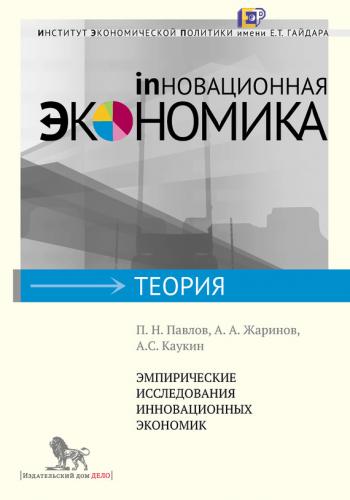36
Для аппроксимации объема накопленных в экономике знаний вместо ВВП на душу населения также предлагалось использовать объем накопленных запатентованных разработок: результаты при использовании этих двух показателей сходны между собой.
37
Islam, N. 2003. What have we learnt from the convergence debate? Journal of Economic Surveys, 17 (3), 309–362.
38
По нашему мнению, обеспечение механического прироста ВВП представляет собой весьма вульгарную целевую установку – вспомним об объемах выплавки чугуна, приходящихся на душу населения за очередную пятилетку в СССР.
39
Bronwyn, H.Hall. 2009. The financing of innovative firms. EIB Papers, 14, 2.
40
Brown, J. R., Fazzari, S. М. and Petersen, В. С. 2009. Financing innovation and growth: Cash flow, external equity, and the 1990s R&D boom. Journal of Finance, 64,1,151–185.
41
Savignac, F. 2008. Impact of financial constraints on innovation: What can be learned from a direct measure? Economics of Innovation and New Technology, 17,553–569.
42
Hajivassiliou, V. and Savignac, F. 2008. Financial constraints and a firm’s decision and ability of innovate: Establishing direct and reverse effects. London School of Economics and Banque de France: manuscript.
43
Сапера, A. and Stoneman, Р.2008. Financial constraints to innovation in the
UK: evidence from CIS2 and CIS3. Oxford Economic Papers, 60, 711–730.
44
Magri, S.2009. The financing of small innovative firms: The Italian case.
Economics of Innovation and New Technology, 18,181–204.
45
Blass, A. A. and Yosha, О. 2003. Financing R&D in mature companies: An empirical analysis. Economics of Innovation and New Technology, 12, 5, 425–447.
46
Rajan, R. G. and Zingales, L. 1998. Financial development and growth. American Economic Review, 88, 3, 558–586.
47
Aghion, P., Fally, T. and Scarpetta, S.2007. Credit constraints as a barrier to the entry and post-entry growth of firms. Economic Policy, October, 731–779.
48
Holtz-Eakin, D., Joulfaian, D. and Rosen, H. S. 1994. Sticking it out: Entrepreneurial survival and liquidity constraints. Journal of Political Economy, 102, 53–75.
49
Bottazzi, Laura. 2009. The role of venture capital in alleviating financial
constraints of innovative firms, EIB Papers, 14, 2.
50
Lerner, Josh. 1996. The Government as Venture Capitalist: The Long Run Impact of The SBIR Program. NBER Working Paper Series.
51
Lerner, J. 1998. “Angel” financing and public policy: An overview. Journal of Banking & Finance, 22, 773–783.
52
Нао, Kenneth Y., and Adam В. Jaffe. 1993. Effect of Liquidity on Firms’ R&D Spending. Economics of innovation and New Technology, 2, 275–282. Hall, B.,H. 1992. Investment and Research and Development: Does the Source of Financing Matter? Working Paper, 92-194, Department of Economics, University of California at Berkeley. Himmelberg, C.P., and В. C. Petersen. 1994. R&D and Internal Finance: A Panel Study of Small Firms in High-Tech Industries. Review of Economics and Statistic, 76, 38–51.
53
Последующее изложение соответствует логике работы: David, Р. А., Hall, В.Н., Toole, А. А. 2000. Is public R&D a complement or substitute for private R&D? A review of the econometric evidence. Research Policy, Elsevier, 29 (4–5), 497–529, April.
54
Jaffe, A. B. 1989. Real effects of academic research. American Economic Review, 79, 957–970; Adams, J.D. 1990. Fundamental stocks of knowledge and productivity growth. Journal of Political Economy, 98, 673–702; Acs, Z.J., Audretsch, D.B., Feldman, M. P.1991. Real effects of academic research: comment. American Economic Review, 82, 363–367; Toole, A. A. 1999a. Public Research, Public Regulation and Expected Profitability: The Determinants of Pharmaceutical Research and Development Investment. Stanford Institute for Economic Policy Research Working Paper, Stanford University; Toole, A. A. 1999b. The contribution of public science to industrial innovation: an application to the pharmaceutical industry. Stanford Institute for Economic Policy Research Working Paper, Stanford University.
55
Link, A. N., Scott, J. T. 1998. Public Accountability: Evaluating Technology-Based Institutions. Kluwer Academic Publishers, Norwell, MA; National Research Council. 1999. Funding a Revolution: Government Support for Computing Research, Report of the NRC Computer Science and Telecommunications Board Committee on Innovations in Computing: Lessons from History. National Academy Press, Washington DC.
56
Nelson, R. R. 1959. The simple economics of basic scientific research. The Journal of Political Economy, 67, 297–306.
57
Arrow, K. J. 1962. Economic welfare and the allocation of resources to invention. In: Nelson, R. (Ed.). The Rate and Direction of Inventive Activity. Princeton Univ. Press, 609–625.
58
Blank, D. М., Stigler, G. J. 1957. The Demand and Supply of Scientific Personnel. National Bureau of Economic Research, New York.
59
По вопросам механизмов (каналов) влияния фундаментальных исследований см. работы: Leyden, D. Р., Link, А. N. 1991. Why are government and private R&D complements? Applied Economics, 23, 1673–1681; David, P.A., Mowery, D., Steinmueller, E.W. 1992. Analyzing the payoffs from basic research. Economics of Innovation and New Technology, 2, 73–90.
60
David, Р.А., Hall, B.H. 1999. Heart of darkness, public – private interactions inside the R&D blackbox. Economics
